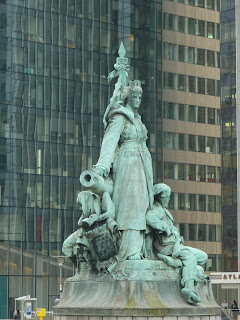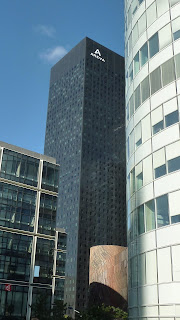Today, it begins at the museum Louvre (equestrian statue of Louis XIV) and continues with the Avenue des Champs-Elysees, Arc de Triomphe and beyond to the Pont de Neuilly and the Great Arch of La Defense.
Defence of Paris
The name of the neighborhood just sculpture "La Défense de Paris, erected in honor of soldiers who defended the city during the Franco-Prussian War of 1870. She recalls the front stabilized here during the siege that Paris had deprived of food for months. She remained at its original place, at the roundabout of Defense, even in the 70s.
Barrias Louis-Ernest (1841-1905) is the sculptor, Thiébaut brothers, the founders. Inaugurated in 1883 on what was the roundabout Courbevoie she resumed her place, slightly shifted in 1983 for the centenary of its founding.
"Since the great Gothic cathedrals, one has done anything like that! " - the CNIT
Since 1950s, the organization of several major exhibitions makes the crucial need large spaces to complete the Grand Palais, has become too "narrow."
The venue is the roundabout Defense in western Paris, on a natural hill at the border between the towns of Puteaux and Courbevoie (near Nanterre) and at the end of the old royal road, on a triangular site next to the roundabout where "The Defense of Paris."
The construction lasted from 1956 to 1958, using a technique Double thin veils of reinforced concrete. Architects, Robert Camelot, Jean de Mailly, Bernard Zehrfuss, accompanied by Jean Prouvé for curtain walls.
The structural engineer, inventor of the double hull thin shell with stiffeners (such as an airplane wing) was Nicolas Esquillan .
Take time to watch this video INA 1958 the construction of Defence
The building is well established a freestanding concrete vault 22 500 m2 for only 6 cm thick and 218 meters of range.
This vault is based on 3 abutments (static element of masonry to contain the thrust of an arch, an arch, a vault, a flying buttress) of concrete rods connected by 44 cables steel. The entries are then by long rectangular blocks.
He became the Centre National des Industries et Techniques . Andre Malraux, Minister of Culture says "Since the great Gothic cathedrals, one has done anything like that! "at the inauguration by General de Gaulle 12 September 1958 , on the occasion of Flower.
In 1978 was built the great stone pedestrian forecourt of the Defence covering railway stations and tracks and all roads. The 3 abutments visually disappear and entrances formed by the rectangular blocks are removed. The exhibition area is reduced and is narrow.
In 1988, the internal structures were completely reworked to have 200 000 m2 (instead of 100 000 m2 above). the architects of the renovation, and are Andrault Parrat, and Lamy Torrieri with Zehrfuss as consulting architect. The CNIT becomes the Centre of New Industries and Technologies .
If the vault and the facades are preserved, the inside is completely transformed with the construction of offices, a luxury hotel and a shopping area, arranged around a large central courtyard. A convention center is built in the basement. But the offices are only partially occupied and the building lack of light.
The structure has regained its original shape and its outer three "feet" after the work from 2006 to 2009, led by architects Brullmann Cuno and Jean-Luc Crochon in collaboration with Pierre Parrat. The slab was partially demolished in the periphery. The access from the square is by five gateways.
To exploit the lower level, which is now the main access to the convention center and a direct connection with the trading room of the station of Defense, the slab inside the building was also partially destroyed.
crown office was remodeled and moved away from the vault again focuses light and space.
The birth of the business center (1958 - 1970)
In September 1958, the Public Establishment for the development of La Défense (EPAD) was created by the State to build, manage and animate the neighborhood of Defense.
An initial development plan is approved by the State in 1964.
The first buildings are to slowly replace the Factories (related to the mechanical and automotive), slums and some neighboring farms.
towers follow a first specification. Tell first generation, they are all the same template: a base of 42 meters by 24, limited to a height of 100 meters and a surface of 30,000 sqm.
designers neighborhood of Defense has set aside space in residential buildings
to make a balanced and lively neighborhood. This bet is it entirely successful?
In 1966, the tower Nobel (then turn Nexity Initiale Tower today ) 107m, architects Jacques and Jean de Mailly Depusse , is the first tower of La Defense. It was inspired by a tower Frank Lloyd Wright. The engineer Jean Prouvé designed the glass facade of the building that uses curved glass on each vertical edge of the building. Its frame structure is steel. Restoration of 2003, retains the same facade.
The first offices are "open space" are introduced and are already not always appreciated by their occupants. Smaller offices opening on the outside creates space for movement and thus induce larger buildings.
These towers first generation induce great regularity, even a certain monotony and does not allow companies to differentiate themselves.
In the early 1970s, Plan 1964 is amended to increase the surface buildings. towers come second generation.
towers of 100,000 square meters out of the earth as round Fiat (1972-1974), now Areva , peaking at 184 m since its foundation, with 44 floors .
A parallelepiped with a black granite facade covered with dark smoke and windows that expand with height to limit the effect of height.
The Architects (Saubot Roger (1931-1999) and François Jullien) have been inspired by this form of monoliths film 2001 Space Odyssey by Stanley Kubrick.
GAN Tower (CB21) is also second-generation built between 1972 and 1974, it measures 179 m high at the roof, 42 floors . It is due to architects Harrison & amp, Abramovitz, JP Bisseuil and his plan is a Greek cross. This tower been restructuring since January 2009. Completely refurbished, the tower will cover the same appearance as the former but 50% more efficient techniques and equipment of last generation to reduce energy consumption by 30%.
Similarly, Ariane tower built in 1975 (Tower General) 152 m high (36 floor), architects Jean de Mailly and Robert Zammit , renovated in 2008.
In 1975, high of 110 m, turn Manhattan is the first tower Defence does not have a rectangular shape, but whose silhouette is curved.
follow ...





















0 comments:
Post a Comment